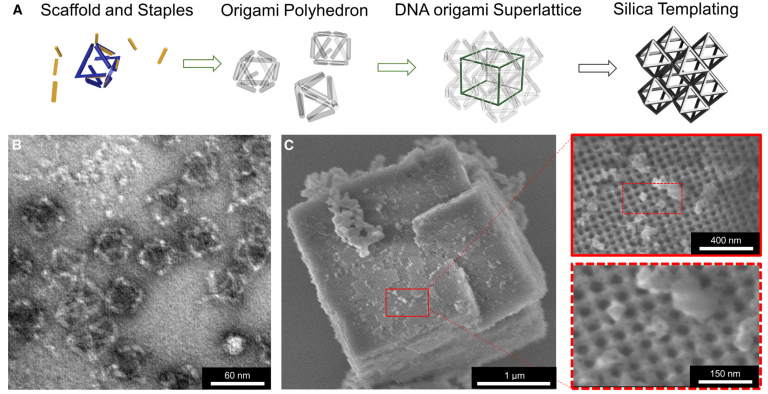Glass-coated DNA material boasts 4x strength of steel
It may not be as catchy a name as Iron Man, but in a fight you might be better off betting on Glass DNA Nanolattice Man instead. Engineers at the University of Connecticut have developed a very strong and lightweight new material out of DNA that self-assembles into lattices, and is then coated in glass.
Strength and weight are often opposing properties – as you increase one, you usually decrease the other. Developing materials that strike the right balance for a given job is a key area of research, and now scientists have found promise in an unlikely combo – DNA and glass.
While it’s mostly known for its dense data-storage properties, DNA could also be versatile as a nanoscale construction material. It can stretch or scrunch, and even self-assemble into various shapes. Glass, on the other hand, might seem fragile, but its tendency to shatter usually comes from flaws like cracks – flawless pieces of glass can be incredibly strong. And intriguingly, tiny pieces of glass are almost always flawless.
The researchers on the new study took advantage of this. They started with DNA that was programmed to self-assemble into lattice-like shapes. This was then coated in a glassy material, forming layers only a few hundred atoms thick. The end result is thin strands of glass-coated DNA which gain strength from the support of both materials, and are lightweight because these strands form a frame that surrounds mostly empty space.
University of Connecticut
In tests, the scientists found that their glass DNA nanolattice material boasted a compressive strength of up to 5 GigaPascals (GPa). This, they say, is four times stronger than steel but with one-fifth of the density.
“For the given density, our material is the strongest known,” said Seok-Woo Lee, co-corresponding author of the study.
The next steps for the research team is to experiment with the formula, including trying different DNA structures and swapping out the glass for materials like carbide ceramics, to see if they can make it even stronger.
“The ability to create designed 3D framework nanomaterials using DNA and mineralize them opens enormous opportunities for engineering mechanical properties,” said Oleg Gang, co-corresponding author of the study. “But much research work is still needed before we can employ it as a technology.”
The research was published in the journal Cell Reports Physical Science.
Source: University of Connecticut
It may not be as catchy a name as Iron Man, but in a fight you might be better off betting on Glass DNA Nanolattice Man instead. Engineers at the University of Connecticut have developed a very strong and lightweight new material out of DNA that self-assembles into lattices, and is then coated in glass.
Strength and weight are often opposing properties – as you increase one, you usually decrease the other. Developing materials that strike the right balance for a given job is a key area of research, and now scientists have found promise in an unlikely combo – DNA and glass.
While it’s mostly known for its dense data-storage properties, DNA could also be versatile as a nanoscale construction material. It can stretch or scrunch, and even self-assemble into various shapes. Glass, on the other hand, might seem fragile, but its tendency to shatter usually comes from flaws like cracks – flawless pieces of glass can be incredibly strong. And intriguingly, tiny pieces of glass are almost always flawless.
The researchers on the new study took advantage of this. They started with DNA that was programmed to self-assemble into lattice-like shapes. This was then coated in a glassy material, forming layers only a few hundred atoms thick. The end result is thin strands of glass-coated DNA which gain strength from the support of both materials, and are lightweight because these strands form a frame that surrounds mostly empty space.

University of Connecticut
In tests, the scientists found that their glass DNA nanolattice material boasted a compressive strength of up to 5 GigaPascals (GPa). This, they say, is four times stronger than steel but with one-fifth of the density.
“For the given density, our material is the strongest known,” said Seok-Woo Lee, co-corresponding author of the study.
The next steps for the research team is to experiment with the formula, including trying different DNA structures and swapping out the glass for materials like carbide ceramics, to see if they can make it even stronger.
“The ability to create designed 3D framework nanomaterials using DNA and mineralize them opens enormous opportunities for engineering mechanical properties,” said Oleg Gang, co-corresponding author of the study. “But much research work is still needed before we can employ it as a technology.”
The research was published in the journal Cell Reports Physical Science.
Source: University of Connecticut
